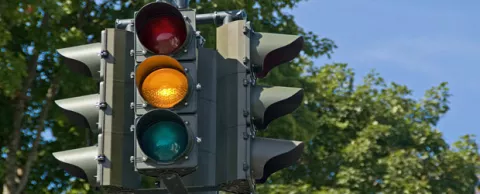
The first large-scale intelligent street lighting deployment is said to have happened in Europe about 10 years ago. Since then the technology has been augmented, adapted and expanded to offer much more than energy-efficient, cost-effective lighting. You probably already know smart lighting networks incorporate sensors and systems that automatically dim the lights as needed and can incorporate video cameras and other features to help ensure public safety, and that they can be remotely managed and monitored. In the story below, we share a few examples of how versatile those networks can be and why they could be a good fit for your city.
Street lighting is as important now as it's always been. Good lighting systems greatly enhance traffic safety on city streets and pedestrian safety on sidewalks, parking lots and other public areas. It's also very expensive, chewing up as much as 40% of a city's energy budget. That alone is sufficient reason for cities to at least consider replacing their traditional street lamps with LED-equipped smart street lighting which, depending on the source or company, can cut lighting energy costs by anywhere from 50 to 80%. And lighting systems themselves are gradually dropping in price.
But there are more reasons for cities committed to becoming connected smart cities to consider smart street lighting networks. Among the most well-known is they can integrate a broad range of third-party applications.
Sensors... all kinds of sensors
Smart street lighting networks typically use sensors to determine whether to increase or dim as needed, as brighten when people are underneath them and dimming when no one is around. But several other types of sensors and applications can piggyback on most networks and help cities in a number of ways.
Sensors can be used to monitor traffic and coordinate smart streetlights depending on traffic conditions and flow. Often used in conjunction with those sensors are others that monitor air pollution levels. In many instances they also can be used in water and gas metering, smart parking management, garbage collection schedule management, digital information and regulatory signage, power management and other city services.
Jack of all trades?
As street lighting technologies evolve, they are becoming more diverse in their capabilities. Companies like Council Associate Partner Huawei say its Connected City Lighting Solution, announced in April, is the first IoT system in the industry to offer intelligent control on many levels. The company's system allows an operator to monitor and control the operation of each street lamp via a GIS-based management system, and through a low-power access system, diagnose and troubleshoot problems, and enhance communications between sensors and the street lamps. Another element of the control system guards against accidents, such as switching on the lights when the sun is out.
Another company, Council Lead Partner GE, has been in the lighting business for a very long time. But it began testing a new generation of lighting last year. GE includes a set of sensors with each light, which could be weather sensors or video cameras. As Bill Ruh, VP and director for global technology said at the time, "We essentially provide the data from sensors for developers who want to build applications for the city, The cost savings and applications depend on how you use them."
The smart street lighting market is becoming more competitive as the intelligent systems become the lighting networks of choice for more and more cities. For that reason, it makes sense that the number of uses for them will continue to grow.
Who'd have thought in the first days of intelligent lighting that in time a car manufacturer would be working on street lighting systems that are also wired to do double duty as EV charging stations?
Related articles…
Smart street lights are coming to China. (Time for your city to take a look?)
Smart street lights shine spotlight on violent crimes
Doug Peeples is a Portland, Oregon-based writer specializing in technology and energy. Follow @smartccouncil on Twitter.



